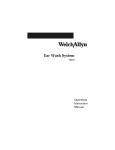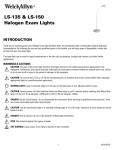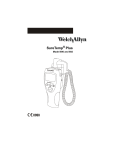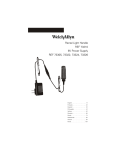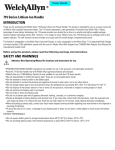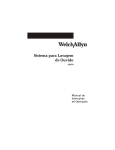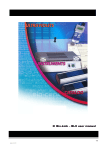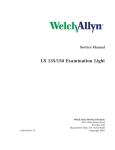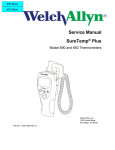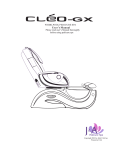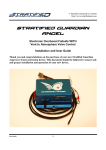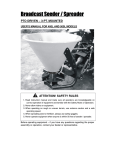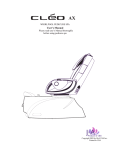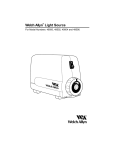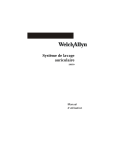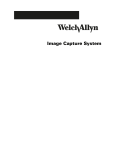Download Using the Ear Wash System - Eickemeyer Veterinary Equipment Inc.
Transcript
Ear Wash System Ear Wash System 29300 Operating Instruction Manual Table of Contents Introduction . . . . . . . . . . . . . . . . . . . . . . . . . . . . . . . . . . . . 1 Getting Started . . . . . . . . . . . . . . . . . . . . . . . . . . . . . . . . . 3 Unpacking and Verifying Contents . . . . . . . . . . . . . . 3 Using the Ear Wash System . . . . . . . . . . . . . . . . . . . . . . . 6 Steps for Irrigation . . . . . . . . . . . . . . . . . . . . . . . . . . 6 Disassembly . . . . . . . . . . . . . . . . . . . . . . . . . . . . . . . 8 Maintenance . . . . . . . . . . . . . . . . . . . . . . . . . . . . . . . . . . . 9 Cleaning and Disinfecting the System . . . . . . . . . . . 9 Troubleshooting . . . . . . . . . . . . . . . . . . . . . . . . . . . . . . . 11 Types of Cerumen . . . . . . . . . . . . . . . . . . . . . . . . . . . . . . 13 Anatomy And Physiology . . . . . . . . . . . . . . . . . . . . 14 Cerumenolytic Agents . . . . . . . . . . . . . . . . . . . . . . 14 Warranty and Service Information . . . . . . . . . . . . . . . . 15 Warranty . . . . . . . . . . . . . . . . . . . . . . . . . . . . . . . . . 15 Technical Service Department . . . . . . . . . . . . . . . . 16 Replacement Parts and Accessories . . . . . . . . . . . . . . . 17 Ordering Information . . . . . . . . . . . . . . . . . . . . . . . 17 Specifications . . . . . . . . . . . . . . . . . . . . . . . . . . . . . . . . . General Specifications . . . . . . . . . . . . . . . . . . . . . . Patents . . . . . . . . . . . . . . . . . . . . . . . . . . . . . . . . . . Eartips . . . . . . . . . . . . . . . . . . . . . . . . . . . . . . . . . . . 18 18 18 18 Introduction Thank you for purchasing the Welch Allyn Ear Wash System. The Welch Allyn Ear Wash System provides a safe and effective way to remove cerumen from patients of all ages. This method of irrigation is much cleaner and safer than other irrigation methods currently on the market. Since it is easy to use with built in safety and simplicity, any healthcare worker at your facility can use this device. The Welch Allyn Ear Wash System provides the following features: • Patient Comfort - Hydrovac action • Patient Safety- High temperature water shut-off valve - Water pressure regulation inside chamber • User Friendly - Visual temperature feedback sensor • Superior Engineering - Fully functional at variable water pressures as well as different faucets This manual describes how to operate and maintain the Welch Allyn Ear Wash System. Please follow these instructions to ensure many years of accurate and reliable service. For additional information on cerumen types and the irrigation process, see the “Types of Cerumen” section. About this Manual This manual serves as guide for ear irrigation using the Welch Allyn Ear Wash System. The Welch Allyn Ear Wash System is intended for use by Healthcare Professionals. Any use other than the intended use invalidates the manufacturer’s warranty. 1 Warnings and Symbols This manual uses the icons and symbols described below. ATTENTION: Refer to the operating instructions. This symbol is intended to advise the user of the presence of important operating or maintenance instructions in the documents accompanying the instrument. Performance specifications verified by ETL Laboratories US The CE mark on this device indicates that it has been tested and conforms to the provisions noted within the 93/42/EEC Medical Device Directive Authorized European Representative Address: FDA Requirements European Regulatory Manager Welch Allyn, Ltd. Kells Road, Navan County Meath, Republic of Ireland Telephone: 353-46-28122 Fax: 353-46-28536 Always inspect the ear before attempting any irrigation. The presence of a perforated or damaged tympanic membrane indicates it is unsafe to irrigate the ear. Do not use this device if the patient has a current or prior history with chronic middle ear infections, diabetes, PE tubes, or immune compromised. If the water is too cold, the patient may become dizzy or experience vertigo. Please verify that the thermal indicator is white before proceeding with the irrigation. Reimbursement Information Ear Cleanings using the Welch Allyn Ear Wash System are reimbursable under CPT Code 69210 - Removal of Impacted Cerumen in one or both ears. 2 Getting Started Unpacking and Verifying Contents Inspect the packaging for any damage incurred during shipping. If you find any damage, notify the carrier. Complete and return the warranty registration card. It validates the warranty and allows Welch Allyn to send announcements of product enhancements. When you unpack your new Welch Allyn Ear Wash System, verify that the following items are included: • Water chamber • Handle/Tubing assembly • One snap-aerator • Three different faucet adapters • Chamber Aerator • One box of eartips (25 ct) • Storage Tray • User’s Manual • Quick Reference Guide If you believe any items are missing, contact your Welch Allyn distributor. Use the figure on page 4 to familiarize yourself with the features of the Welch Allyn Ear Wash System. 3 Diagram of the Welch Allyn Ear Wash System 1 2 12 14 13 15 3 10 4 11 5 9 7 8 6 16 1 Faucet Interface 9 Water Flow Actuator 2 Faucet Adapter (Optional) 10 Water Temperature Sensor 3 Snap Aerator 11 Cerumen Trapping Screen in Eartip 4 Snap Connector with white ring 12 Water Jet Output 5 Handle Rest Grip Ring 13 Water Suction Input 6 Irrigation Port - Irrigation water to ear (blue) 14 Disposable Eartip 7 Return Port - Return water from ear (black) 15 Eartip Removal Tab 8 Return Water Exit Port 16 Chamber Aerator 4 Faucet Aerator Installation 1. Remove your current aerator from your faucet, including any original washers. You may need to use a pair of pliers to remove your aerator. If you still have difficulty in removing it, soak your current aerator in distilled vinegar for about twenty minutes and try again. 2. Try attaching the snap aerator to your faucet by turning it counterclockwise. If it does not fit, try using one of the adapters that is included with the unit. Attempt to match the adapter to your faucet and then attach the snap aerator. Verify the rubber washer on the snap aerator and adapter matches to the old washer on your faucet. If you need to use the threadless universal adapter (only available in certain regions), you may need to remove the inner rubber o-ring if it is too small for your faucet. 3. Once the snap aerator is attached to the faucet, the ear cleaning chamber is easily attached or removed from the snap aerator. You can still use your sink normally when the Ear Wash System is not attached to the snap aerator. Chamber Aerator Installation The chamber aerator is an optional attachment that is necessary if you are experiencing a significant amount of water splash around your sink. When the chamber aerator is attached, replace the chamber normally into the storage tray. 1. Find the notch located on the top of the chamber aerator and line it up with the blue irrigation port on the chamber. 2. Gently press the chamber aerator against the chamber until it is snug. NOTE: The chamber aerator is only capable of attaching to the chamber if it is aligned correctly. It should go on relatively smoothly and there is no need to force it onto the chamber. 5 Using the Ear Wash System Steps for Irrigation Always inspect the ear before attempting any irrigation. The presence of a perforated or damaged tympanic membrane indicates it is unsafe to irrigate the ear. Do not use this device if the patient has a current or prior history with chronic middle ear infections, diabetes, PE tubes, or immune compromised. Attaching the Tubing and Chamber 1. Connect the tubing to the chamber. Match the black connector to the black return port on the side of the chamber. Match the blue connector to the blue irrigation port on the lower side of the chamber. 2. To attach the chamber to the faucet, pull down the white plastic ring on the top of the chamber, and then insert the chamber over the snap aerator on the faucet. When the chamber is positioned, release the white plastic ring. The chamber is now secure. Attaching an Eartip 1. Line up the grooves on the side of the eartip with the corresponding indentations on the handle interface. Verify that you are attaching the eartip with the tab facing upwards. 2. Press firmly on the eartip until it is flush against the handle interface. You will feel a slight snap when the eartip is in place. Irrigation 1. Initially, you may cover the patient with a cloth drape to eliminate splashing onto his or her clothes. Once the technique of sealing the ear canal is mastered, this is not necessary. 2. Begin to run water through the unit by first turning the cold water on completely. Then gradually turn on the hot water until the water exiting the bottom of the chamber feels close to body temperature. 6 3. Check the temperature of the irrigating water by looking at the thermal sensor while depressing the water flow actuator. If the thermal sensor is blue, the irrigating water is not warm enough. If the thermal sensor white, the water temperature is at least 90° F and the procedure may begin. You must depress the actuator on the handle for the temperature sensor to function correctly. If the water is too cold, the patient may become dizzy or experience vertigo. Please verify that the thermal indicator is white before proceeding with the irrigation 4. To irrigate the ear, grasp the patient’s pinna. Pull gently back to straighten a child’s ear canal or up and back for an adult. While maintaining tension on the pinna, insert the tip of the handle into the ear to create a seal. Squeeze the actuator on the handle. By adjusting how much force you push on the actuator, some control over the flow rate is attained. 5. Aim the stream of water toward the ear canal walls by rotating the handle during the irrigation. Flood the ear with water. The suction return system will return the discharge away from the ear. (See the quick reference guide for a diagram of correct water flow). 6. During the irrigation, conversation regarding patient status will provide confidence to the patient. 7. If the temperature of the irrigating water becomes too hot, the unit will restrict the flow to the handle, while continuing to discharge out the bottom of the unit. For the unit to reset, bring the water temperature down to a safe level by adjusting the knobs on the faucet until the water cools sufficiently. 8. Release the actuator and keep the eartip in the canal for 5 to 10 seconds to vacuum any residual irrigating water. NOTE: The procedure typically takes 30 seconds to 5 minutes depending on the type of cerumen and whether or not a wax softening agent is used. In severe cases, the process could take longer. 7 9. When the irrigation is complete, grasp the tab located on the eartip of the device and pull the eartip off of the handle with a downward motion. This eartip is disposable. Please place in an appropriate receptacle. If there is no water flow out of the eartip and the actuator is depressed, check to see if the hot water shut-off has tripped by running cold water through the unit. This should restore water flow to the handle. Eartips are intended for single use only. Discard after use. Disassembly 1. Turn off the faucet and disconnect the tubing from the chamber. 2. Detach the chamber from the faucet. Press down the white ring on top of the chamber and then pull the chamber from the snap aerator. The chamber will drain through the open hose ports at the front and bottom. 3. To remove any stagnant water from the tubing, place the open end of the tubing over the sink. Hold the handle higher than the tubing and squeeze the actuator. Roll the tubing up into a coil, holding the handle higher than the tubing. The water should run out of the open end into the sink basin. 8 Maintenance Cleaning and Disinfecting the System Clean the Ear Wash System after every use and disinfect at the user’s discretion. Pour ½ cup of cleaning solution into chamber. Cleaning the unit with soap and water will eliminate any debris and reduce the number of microorganisms in the tubing. Disinfect the unit with 70% isopropyl alcohol or 10% bleach/90% water solution to Place handle into 3½ cup of cleaning eliminate most bacteria and solution fungi growth. It is recommended that alcohol is used since it will help to evaporate any remaining water in the tubing. 1. Remove the eartip and discard. 2. Clean the outside of the chamber, handle and hose with a soft cloth saturated with a mild solution of soap and water 3. To clean the unit, prepare a 4-cup solution of soap and water. To disinfect the unit, prepare a 2 cup solution of Isopropyl Rubbing Alcohol or 10% bleach / 90% water solution. 4. Detach the chamber from the faucet. Leave hoses attached to the unit. Pour ½ cup of the solution into the top opening of the coupler. Save the remainder of the solution later steps of this procedure. 5. Replace the chamber on the faucet head and submerge the exposed handle interface surface (where the tip attaches) into the remainder of the solution. 6a. To clean the unit, turn on the water. Squeeze the actuator to allow the solution to flow from the handle into the container. The suction line will remove the solution. Continue this process for 5 minutes. 9 Remember to keep the exposed tip of the handle submerged in the solution. 6b. To disinfect the unit, turn on the water. Do not squeeze the actuator. After half of the solution is removed, turn the water off at the faucet. Remove handle from solution and rest in the handle rest / grip ring. This will trap solution in the return line and allow effective disinfection. If unit is used on a patient with compromised skin, substitute a solution of .55% Ortho-Phthalaldehyde (Welch Allyn recommends use of Cidex OPA). Follow manufacturers recommendations on soak times for maximum benefit. Repeat the cleaning procedure above to remove any residual disinfecting solutions. 7. Turn the water off and remove both tubes from the chamber. 8. To remove any stagnant solution in the tubing, disconnect the hoses from the chamber and place the open end in the sink. Hold the handle higher than the tube and squeeze the actuator. The water will run out of the open end into the sink basin. 9. Remove the chamber from the faucet. Allow the chamber to drip dry. Replace the unit in its holding container. 10. To facilitate a recommended thorough flush and faster drying, pour Isopropyl rubbing alcohol inside the chamber and hoses. If hard water/ calcium buildup is a concern, a solution of 100% vinegar can be substituted. Allow the vinegar to soak in the chamber for no more than 2-3 minutes. A final flush of isopropyl alcohol is required. 10 Troubleshooting If your Welch Allyn Ear Wash System is experiencing problems, consult the following table to find the symptom and the likely cause and the solution. If the information in this table does not describe or solve the problem you are having, contact the Welch Allyn Technical Service Department or an authorized Welch Allyn Distributor to help you. See Service and Warranty Information Card for more information. Problem No water is coming out of the handle even though I am pulling the actuator. Excessive water leaking from the ear. Possible Cause Solution The temperature shut-off safety feature has activated due to the hot water temperature. Run COLD water through the system for 10-30 seconds. This will reset the temperature shut off safety feature and allow water to flow again. There is a kink in the tubing. Make sure there are no bends in the tubing restricting the flow of water. The tubing on the INSIDE of the handle is restricting water flow. Prime the actuator 25 - 50 times until water begins to flow normally. The water is not turned on high enough. Turn the cold water on full in order for the suction system to work properly (but still within the right temperature range). Eartip attachment problem. Replace the eartip with the tab side pointing upwards. Tubing connection problem. Ensure that both tube fittings are fit snugly into the chamber. Incorrect technique. Check the Quick Reference Guide to verify you are aiming the water correctly. 11 Problem Possible Cause Solution Lack of a clean water stream coming from eartip. Installation of eartip has caused a problem. Apply a new eartip with the tab side pointing upwards. The water splash is making a mess or splashing onto adjacent electrical units. Excess water pressure from the water line. Ensure that the chamber aerator is attached to the bottom of the chamber. Installation of eartip has caused a problem. Apply a new eartip with the tab side pointing upwards. There is leakage from the chamber aerator and/or adapter Tighten the aerator and/or adapter with a pair of pliers. The return water exit port is clogged on the bottom of the chamber. Remove the chamber from the faucet and dislodge any foreign materials from the exit port. Proceed with the normal cleaning procedure. There is an internal malfunction. With an eartip attached, spray water from the handle into a graduated cylinder or measuring cup for exactly 20 seconds. If there was less than 90 mL or more than 110mL of measured water, contact your Welch Allyn Technical Service Department. The water pressure from the eartip seems too high or too low. 12 Types of Cerumen Cerumen is the natural by-product of the ear canal. It lubricates the skin lining in the ear canal, acts as a water repellent, and entraps dust, hair follicles, and foreign bodies. Cerumen can take many different forms which affect the process and time to remove. There are generally two different types of cerumen found in the ear canal: dry and wet. The following are subtypes of cerumen that you will commonly encounter and how they may affect the irrigation procedure. White/Flaky Cerumen This form of cerumen will easily dissolve in the irrigation water. The irrigation procedure is relatively short, and a cerumenolytic agent is not always necessary. Often you will not see solids trapped in the eartip with this form of cerumen; rather, you will see some of the dissolved cerumen trapped in the eartip screen. The rest of the dissolved cerumen will leave through the exit port of the chamber. Light Brown/”Jelly-Like” Cerumen This cerumen resembles the consistency of petroleum jelly and does not completely dissolve in the irrigation water. Some solids may be present in the eartip, and the procedure time is slightly longer than for the white/ flaky variety. A cerumenolytic agent is recommended to speed the time of irrigation. Dark/Hard Cerumen This cerumen is often found lining the walls of the canal and forms a plug in the patient that can cause significant hearing loss. Large solids of cerumen are seen trapped in the eartip and the procedure time is often longer than the wet/”jelly-like” cerumen. A cerumenolytic agent is often necessary to speed the time of irrigation. 13 Anatomy And Physiology • Cerumen is produced in the outer third of the ear canal and naturally moves to the outer ear as new tissue grows from the area around the tympanic membrane. • Normal cerumen routinely becomes a medical issue when it impedes the physicians ability to visualize the tympanic membrane. Less frequently, cerumen can accumulate and harden, in the canal causing occlusion of the ear canal. In the most severe cases cerumen can become ‘impacted’ in the deep (bony) canal causing pain and temporary loss of hearing. Cerumenolytic Agents • Cerumenolytic agents are those agents designed specifically to dissolve or soften cerumen. • Most softening agents, particularly over-the-counter products contain carbamide peroxide which is the only agent the FDA considers safe for loosening or softening cerumen. • In some instances, it is necessary to soften cerumen prior to removal or instead of removal. 14 Warranty and Service Information Warranty Welch Allyn, Inc. warrants the Ear Wash System to be free of original defects in material and workmanship and to perform in accordance with manufacturer’s specifications for a period of one year from the date of purchase. If this instrument or any other component thereof is found to be defective or at variance from the manufacturer’s specifications during the warranty period, Welch Allyn will repair or replace the Ear Wash System or component(s) at no cost to the purchaser. This warranty only applies to products purchased new from Welch Allyn or its authorized distributors or representatives. The purchaser must return the product directly to Welch Allyn or an authorized Ear Wash System distributor or representative and bear the cost of shipping. This warranty does not cover breakage or failure due to tampering, misuse, neglect, accidents, modification or shipping, and is void if the instrument is not used in accordance with manufacturer’s recommendations or if repaired or serviced by other than Welch Allyn or a Welch Allyn authorized representative. NOTE: Return of the instrument registration card is required for proof of purchase and warranty validation. 15 Technical Service Department For customers in North America, please return instruments requiring service to Welch Allyn or an authorized Welch Allyn Service Representative. Please call the Technical Service Department for a Return Authorization Number prior to shipping the Ear Wash System back to Welch Allyn for repair. United States: Canada: Welch Allyn, Inc. Attn: Technical Service Department 4341 State Street Road Skaneateles Falls, NY 1314-0220 Telephone: 1-800-535-6663 1-315-685-4560 Fax: 1-315-685-3361 Welch Allyn, Ltd - Canada 160 Matheson Blvd. E., Unit #2 Mississauga, Canada L4Z 1V4 Phone: 905-890-0004 Fax: 905-890-0008 For customers outside of North America, return your unit to a local, authorized Welch Allyn distributor or to your nearest Welch Allyn service center. Welch Allyn, Ltd. – UK Welch Allyn France Cublington Road Aston Abbots, Buckinghamshire England HP22 4ND Phone: 011-44-1296-689905 Fax: 011-44-1296-682104 814 rue Charles de Gaulle 77100 Mareuil les Meaux France Phone: 011-33 1 60 06 33 66 Fax: 011-33 1 60 09 67 97 Welch Allyn, GmbH PSC Welch Allyn, LTD - Singapore Zollerstrasse 2-4 72417 Juningen, Germany Phone: 011-49-7477-927173 Fax: 011-49-7477-927193 300 Beach Road #25-08 The Concourse Singapore 199589 Phone: 011-65-291-0882 Fax: 011-65-291-5780 Welch Allyn China Service Center Welch Allyn, Ltd. - Australia Room 708, 227 Huang Pi Road, North Central Plaza Shanghai 200003, China Phone: 011-86-21-6327-9631 Fax: 011-86-21-6327-9632 Metro Center Unit 5 38 South Street Rydalmere NSW 2116, Australia Phone: 011-(612) 9638-3000 Fax: 011-(612) 9638-3500 For service in Latin America and the Caribbean region, contact: MD International 11300 N.W. 41st Street Miami, FL 33178 USA Phone: 1-305-669-9003 Fax: 1-305-669-1971 16 Replacement Parts and Accessories Ordering Information To order replacement parts or accessories, contact your Welch Allyn Service Representative or call the Welch Allyn Customer Service Department in Skaneateles Falls, NY (USA) directly at: 1-800-535-6663 Monday through Friday, 8:00AM to 8:00 PM EST Part Part Number Eartips (Case of Eartips) 29360 Tubing (Hose Assembly) 29330 Snap Aerator 29370 Aerator Adapter Kit: Domestic International 29371 29355 17 Specifications General Specifications The specifications common to all of the major components of Welch Allyn Ear Wash System are listed the following table. Operating Temperature: 50° - +104° F(10° - +40° C Storage Temperature: -40° - +120° F(-40° - +49° C) Flow Rate from Eartip: 100 mL (0.0264 gal) of water per 20 seconds at operating pressure. Source (faucet) Water Pressure Range: 40 - 110 Psi (275KPa - 758 Kpa) Minimum Source Water Flow Rate: 7.5 l/min (2 gal/min) Water Pressure from Eartip: 10 Psi (69kPa) Patents U.S. Patent Number 5,685,851; other patents pending Eartips • Bio-compatible, latex-free, insert type • One size fit patients from pediatric to adult • Single-use only • Fits most round ear canals 18 Welch Allyn, Inc. 4341 State Street Road PO Box 220 Skaneateles Falls, NY 13153-0220 Tel: (315) 685-4560 1 (800) 535-6663 Printed in the U.S.A. Part No. 293044 Rev. B
























